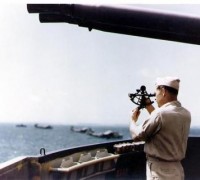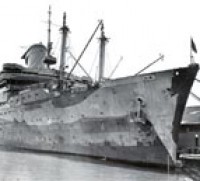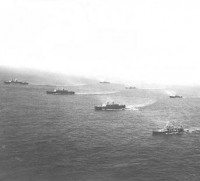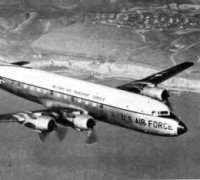COMMANDER SOUTH ATLANTIC FORCE AT RECIFE - COMMANDER SOUTH ATLANTIC
30)THE SOLANT TRIPLE PLAY
The first days of 1944 were truly spectacular. Three German surface blockade runners invaded the area, and the Fourth Fleet took care of them in a thoroughly businesslike manner. January 1 and 2 brought nothing more exciting than the news that on Fernando de Noronha the mooring mast for blimps had been made ready. But the third day of the month saw the fireworks start to explode, and for the next three days the Fleet had plenty of activity.
The first of the German ships was the Weserland. Her coming was no particular surprise to the Fleet, since advance information had already been received to the effect that blockade runners would shortly have to be dealt with. This news had led to the establishment of an air blockade barrier. The barrier operations were designed to close to enemy ships practically the whole extent of the South Atlantic narrows between Africa and Brazil. The barrier proved effective.
No unplotted northbound vessel passed through the Western South Atlantic during the time it was in effect. On January 1, eleven FB4-Y-1 airplanes and approximately fifteen crews were assigned to this patrol. Six planes and nine crews operated from Ascension, while five planes and six crews worked out of Natal. The unit had its sole mission the maintenance of a barrier patrol to intercept enemy blockade runners known to be traveling northward through the South Atlantic.
The first of January brought the original sighting of the first doomed ship, by a plane based on Ascension. At that time the Weserland, as she ultimately proved to be, was in 09° 35' S, 23° 45' W, traveling on course 060° (T), at a 10 knot speed. The pilot at once realized that here was a ship not on the friendly plot for the day. He circled to investigate, challenging by blinker. The surface vessel hoisted a four letter call, then immediately hauled it down, before the plane crew could read it.
The plane next closed in and made out the name Glenbank on a small bridge nameplate. Following this, the pilot challenged several times more, and the ship failed to hoist either a call or an authenticator. The plane opened fire and the ship replied, getting rather the better of the exchange. It scored three hits on the aircraft, disabling one engine and wounding a crew member engaged in taking photographs.
On this, the plane broke off the engagement and retired to base at Ascension. Another plane came out to watch the ship, of whose enemy character there now remained no doubt. Meanwhile, the call went out to nearby supporting surface units to close and board the stranger. The Destroyer Somers had the assignment of running down the intruder, but due to communications difficulties the message delayed in getting to her. Before the Destroyer reached the scene, during the early hours of January 3, the plane patrol had changed several times. Contact, however, had never been lost, and the planes were able to guide the Somers unerringly to the spot. When she reached it her guns went into action. The first report, issued shortly after midnight on January 3, read "Attacked and badly damaged enemy ship". About three hours later came the word "Ship now sunk. Identified as Weserland. 134 survivors in German Naval uniform were rescued.
The following had happened. By the time of closing, the Somers knew the target to be an enemy, it already having fired on two planes. If a blockade runner, its armament would probably be light; if a raider, it might carry guns up to 5.9, torpedo tubes and motor torpedo boats; possibly radar. Since both planes fired on had been hit, the German crew must be well trained. The planes, moreover, had dropped flares, which would certainly let the enemy know that a surface vessel was in the vicinity and would probably put him on the alert. These factors taken together strongly indicated the need for caution. It being night, the Destroyer decided to use its superior speed to maneuver so as to place the target down moon, then close to hitting gun range and open fire, attempting surprise. Should the enemy appear armed and return fire, a torpedo attack would be pressed home. If not, the target would be sunk by gunfire.
Accordingly, the Somers, moving at a 25 knot speed narrowed the range to 7000 yards. At 0223 the order was given to "commence firing", using a modified down ladder; first salvo to hit, second up 500 yards, third down 1000 yards. Survivors from the Weserland later said that the first salvo scored, one shell killing four men on the bridge. At that moment the order was given aboard the blockade runner to abandon ship. Meanwhile, the Somers closed the range to 6000 yards, where its gunnery proved highly effective. The Destroyer continued firing until 50 flashes from hits and two explosions in the center of the ship had been observed. Then the order was given to cease, but since no flames were visible, and the ship did not appear to be sinking, firing resumed at 5000 yards.
Every salvo struck, and produced what appeared to be from five to six explosive flashes. The target sank at 0300, in Latitude 14° 55' S, Longitude 21° 39' W. Having destroyed the enemy craft, the Somers immediately set about picking up survivors. After one boat had been rescued, it seemed wisest to move off for a time and return after daylight to take up the rest. This course was followed, and, beginning at dawn, a total of 7 lifeboats, and one life raft, containing 17 officers and 116 men, was collected by the Somers, which landed the prisoners in Recife on January 6.
Personal papers and belongings taken from the survivors established the sunken ship's identity as the German Merchantman Weserland, en route from Japan to Germany. No one had any chance to observe the cargo, but survivors stated that it consisted of rubber, tin, and wolfram. Next day came the turn of the Rio Grande. Her interception and destruction go principally to the credit of Task Group 41.1, consisting of the Omaha and Jouett, with Rear Admiral Read in command. The group received orders to depart Recife on January 2, on ocean patrol. The primary mission was the support of the barrier sweep between Natal and Ascension. By the 4th, the two ships were operating in the vicinity of 06° 11' S, 25° 57' W, conducting air search with the Omaha's planes.
Flying operations for the day extended 60 miles on either side of base course 153° (T), the length of the search being 175 miles. At 1025, while in Latitude 06° 28' S, Longitude 25° 51' W, the Omaha sighted a ship bearing 150° (T), about 20 miles distant, and at almost the same time the planes saw the stranger. Thereupon the Omaha directed one plane to investigate the contact and the other to go ahead with routine patrol. Thirteen minutes later the Omaha and Jouett, on signal, proceeded to intercept the runner at a 20 knot speed. While the two ships were increasing speed and reducing the range, the stranger started to send a message. Very little of this could be made out, because the Omaha killed it by jamming on 500 kcs., in accordance with Force doctrine.
Meanwhile, the blockade runner had not shown her colors, nor had she hoisted her call; in fact she had offered no identification, though the Task Group had challenged. By 1107, with range cut down to about 20,000 yards, the watches could see smoke aft on the ship. Whether this came from an explosion, a screen, or from fire could not be learned at the moment, but a little later the Omaha aircraft reported that explosions had occurred aft and midships and that the crew had abandoned ship in lifeboats. Just prior to this the Task group had opened fire, at first for the purpose of forcing the boats back to the ship, but later starting fire to the target itself. At 1114, the Omaha and Jouett ceased firing on orders from Admiral Read. A moment later, when it was seen that the lifeboats had no intention of returning to the ship, they reopened at a 7,600 yard range and continued until the target sank, partly from gunfire and partly from demolition charges set by the crew before abandoning ship.
The Task Group proceeded to clear the area at high speed, and, as it did so, passed four well equipped lifeboats containing the runner's crew, the estimated number being 50. In one boat there appeared to be officers in white uniforms. The group made no attempt to recover the survivors. Shortly after the action, following decoding, it was found that the call sent out by the unidentified ship just before being attacked was that of the SS James Lykes, American. However, the characteristics of the sunken runner did not check with those of the Lykes. Moreover, the strangers conduct had been utterly incompatible with that of an American ship. The following day, January 5, the Task Group passed again close to the area of the sinking and went through a large oil slick, presumably from the runner. It had a distinct odor of vegetable oil. The Jouett was ordered to collect various samples of cargo still afloat and did so. The most important item was crude rubber in bales of 245 kilograms, with French Indo China markings.
On the day of the sinking, from observations of the vessel's characteristics, it had been estimated that she could be the Rio Grande, if northbound, or the Elsa Essberger, if southbound. After the investigation of the wreckage on the 5th, the nature of the cargo definitely established the ship as northbound and from the Orient. This definitely placed her as the German Rio Grande. She had not been detected prior to being spotted by the Omaha, but she had still to pass through the barrier, where planes beyond a doubt would have picked her up.
Task Group 41.1 also had accounted for the Burgenland, third of the German runners. On January 5, a few hours after investigating the floating cargo of the Rio Grande, the Group was still engaged in its primary mission of supporting the barrier sweep and intercepting blockade runners. The Omaha and Jouett, at 1419, while in Latitude 06° 31' S, Longitude 25° 50' W, intercepted a message from plane number 5 of Patrol Squadron 203, addressed to the Senior Naval Aviator, Natal. The message announced that the pilot was investigating a ship. Decoded further, the report stated the vessel to be the U. S. Freighter Floridian, in Latitude 08° 38' S, Longitude 25° 43' W, on course 085°, speed 12 knots. The ship concluded the message, would hoist no call.
Admiral Read consulted his plot for the day and ascertained that the Floridian did not belong in the position given. This made the contact definitely suspicious, and at high speed the Group changed course to intercept the ship. A message went to plane number 5, instructing the pilot to keep the Admiral informed of the vessel's direction and speed. Presently there came a reply, showing a new course on the part of the contact. At 1626, Admiral Read sent a message to the Commander Fourth Fleet and the Senior Aviators at Ascension and Natal, requesting them to take immediate steps to keep the ship under vigilance. A little later, plane number 5 informed Natal that it had reached its limit of endurance, and that it could remain on the scene no longer; giving a previously stated position as the last available for the suspicious ship.
A relief plane, somewhat delayed, departed from Natal, and the Omaha and Jouett took separate courses to broaden their search and to cover the possibility of the ship's altering course again. At 1853 the Omaha made a radar contact bearing 230° (T) and changed course to close. At 1901 the mast of the ship was sighted, and 20 minutes later the Omaha challenged, receiving no reply. When the Cruiser had closed the range to 22,000 yards it fired a shot across the stranger's bow. Four minutes later smoke was observed coming from the amidships part, following which the deck house burst into flame. Data as to characteristics which the Omaha possessed, made identification as the Burgenland possible without delay. At 1933, on Admiral Read's orders, the Omaha with the Jouett, which had meanwhile come within range, both commenced firing and continued for ten minutes. During this time the target was heavily hit.
At 1952, a weak explosion took place on board the runner, as well as explosions from small caliber ammunition. Five minutes later she was seen to be settling rapidly, and within a moment or two the Burgenland sank, in Latitude 07° 29' S, Longitude 25° 37' W. Four boatloads of survivors had abandoned ship, but Task Group 41.1 had not the time to attempt rescue. Admiral Read quickly cleared the area of sinking, retiring to the eastward. Survivors of the Rio Grande and Burgenland were collected and brought ashore in installments. The Davis picked up 21 of the latter's men on January 7, and the next day the Winslow rescued 35 more. Seventy-two men from the Rio Grande were recovered by the Marblehead, also on January 8. On the 11th, 22 more survivors from the Rio Grande reached Fortaleza in a whaleboat, to be taken into custody by the 10th Brazilian Military Region Commander. Finally, on the 13th, the Brazilian Minelayer Camocim, while escorting a Rio-Trinidad convoy, picked up a whaleboat with 25 Germans and 9 Italians. This accounts for all the survivors of the three sinkings.
Without exaggeration, it can be said that the German war effort suffered as a result of these losses. Cargo consisting largely of raw rubber would float and was too precious to be allowed to drift idly in the South Atlantic. Two Sea Going Tugs, the Seneca and Carib, spent a week collecting the scattered bales, and in that time salvaged rubber enough to make tires for 5000 bombers. The rubber floated only two or three inches out of the water, and of course lay widely scattered. It had to be located and handled bale by bale. The poorest hunting netted 22 bales for one ship in a day; the best brought 226 onto the deck. Crews of the Tugs who worked at this had to use hooks and tongs.
The rubber was very soft and difficult to hook fast. Whaleboats plied from the Tugs and the crews competed among themselves for discovering and hooking the largest number of bales. The Whaleboat record stood at 50 for the best catch. All told, the salvage came to 1996 bales of rubber, including 4 rescued by the Somers, and 4 barrels of tallow. The Seneca won its competition with the Carib by a narrow margin. The prisoners taken in the Weserland, Rio Grande, and Burgenland operations all subsequently went to the United States for interrogation.
Hyper War. Commander South Atlantic Force. U.S Naval Administration in WW II.



